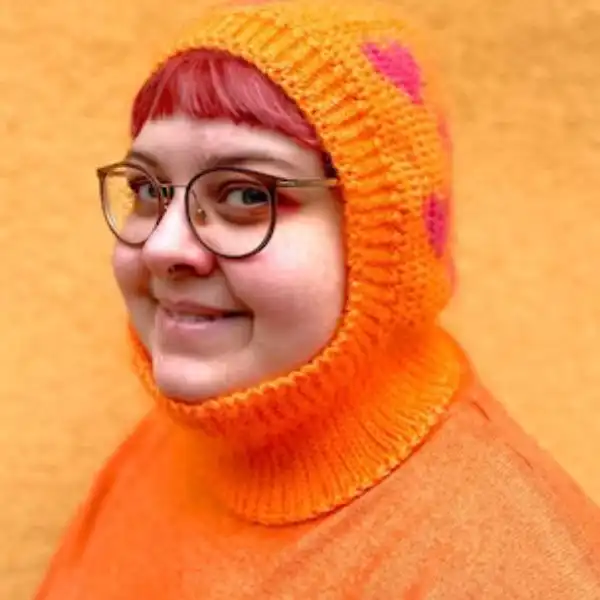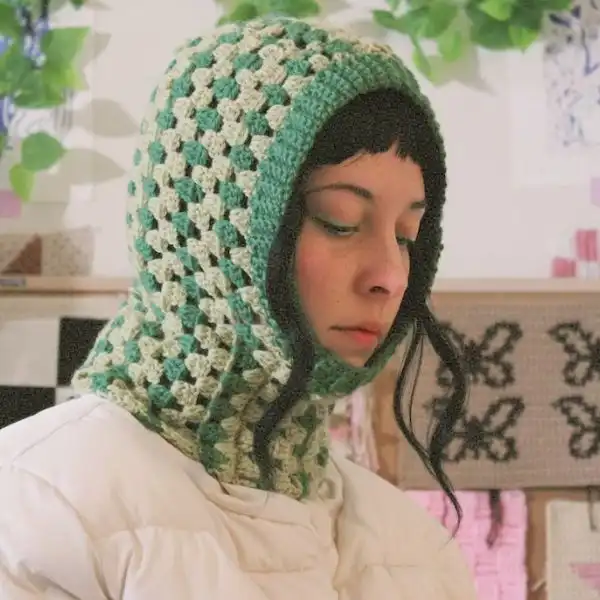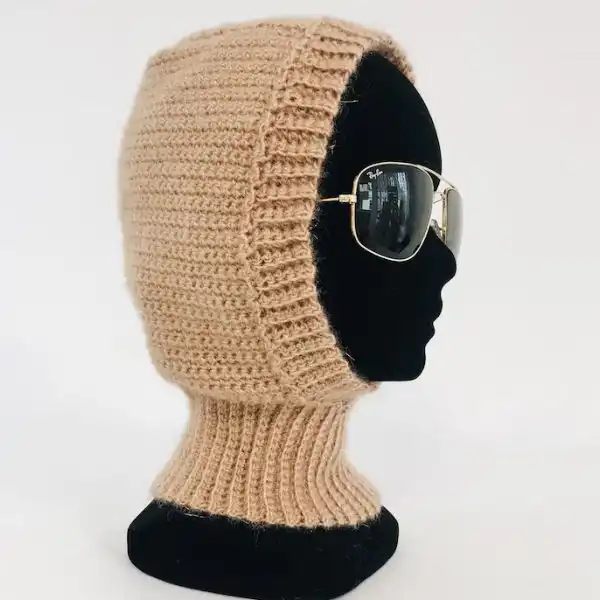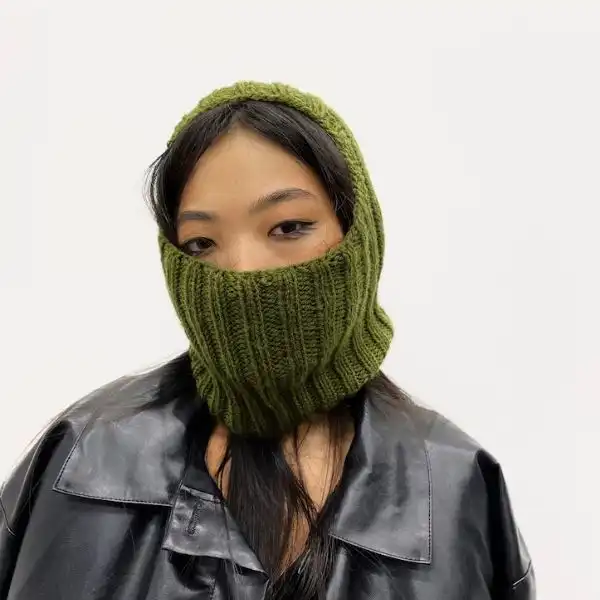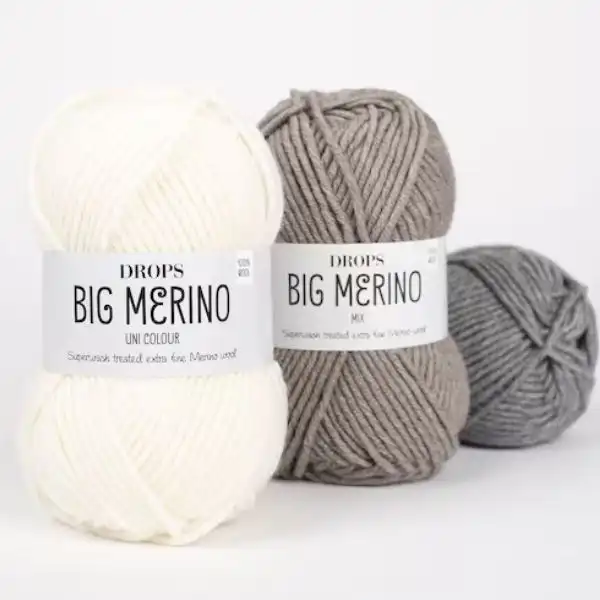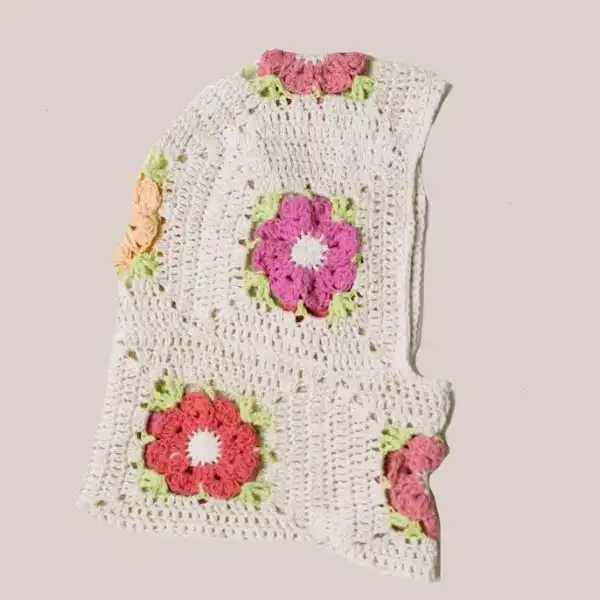Welcome, yarn enthusiasts! Get ready to dive into the delightful world of crochet balaclava patterns. A world where your imagination is the only limit! These patterns are not just winter warmers but also a creative playground for those curious fingers.

Whimsical in design and versatile, they’re perfect for transforming chilly days into cozy adventures. Whether you’re a seasoned pro or a courageous newbie, we have designs to challenge and delight you.
Prepare for a journey through intricate stitches, playful colors, and diverse textures that take ‘head-turning’ to a new level! So, grab your crochet hook and your favorite yarn.
It’s time to create something fantastic to keep you and your loved ones warm and stylish. The world of crochet balaclava patterns awaits!
What Is A Balaclava?
A balaclava, also known as a ski mask, is a type of headgear that covers the whole head, face, and neck, leaving only parts of the face (usually the eyes and sometimes nose or mouth) exposed.
Your knitted balaclavas were originally made from wool; today, they can be made from various materials, including cotton, fleece, or synthetic fibers.
They are often used in cold weather or winter sports to provide warmth and protection from the elements. Fashion-forward variants have emerged in recent years, turning this practical item into a trendy accessory.
Is It Worth To Crochet A Balaclava?
Crocheting a Balaclava is well worth the time and effort! A homemade balaclava provides unrivaled warmth and comfort and allows you to inject your personality into your winter gear through unique patterns and color combinations.
This rewarding project can cater to various skill levels, making it a fantastic challenge for any crocheter. Plus, these cozy pieces make heartfelt gifts.
So, whether you’re honing your craft or creating personalized presents, crocheting a balaclava promises an engaging, satisfying experience with the joy of donning or gifting a one-of-a-kind accessory.

Popular Stitches To Crochet A Balaclava
Single Crochet (SC): The simplest and most fundamental stitch, single crochet, creates a tight, dense fabric perfect for balaclavas.
Insert your hook, yarn over, pull the yarn through to make two loops on the hook, yarn over again, and pull through both loops. This stitch is great for beginners and offers a solid base for any pattern.
Half Double Crochet (HDC): A versatile stitch denser than double crochet but taller than single. Yarn over, insert your hook into the stitch, yarn over, and pull through.
You’ll have three loops on your hook, then yarn over and pull through all three. HDC creates a medium-thickness fabric, ideal for a comfortable, snug balaclava.
Double Crochet (DC): This stitch is taller and creates a looser fabric than single or half-double crochet. Yarn over, insert the hook into the stitch, yarn over, and pull through.
Yarn over and pull through the first two loops, then yarn over again and pull through the last two. DC is great for adding decorative touches or creating a lighter, more flexible balaclava.
Slip Stitch (Sl st): The slip stitch is primarily used to join rounds or to move your yarn across a row without adding height.
Insert your hook into the stitch, yarn over, and pull the yarn through both the stitch and the loop on your hook. Though not often used to create fabric, it’s handy for finishing off your balaclava or adding finer details.
Front Post Double Crochet (FPDC) and Back Post Double Crochet (BPDC): These stitches create raised, textured patterns, adding a fun visual element to your balaclava.
They’re performed similarly to double crochet, but instead of working into the top of the stitch, you work around the post of the stitch below. FPDC and BPDC offer a playful way to add personality to your crochet balaclava.
How To Determine The Size Of A Balaclava?
When crocheting a balaclava, it’s essential to consider the size to ensure a comfortable and secure fit. Here are some standard sizes and how to determine the right one:
Child Size: Suitable for children aged 4 to 12 years, typically measures 18-20 inches in circumference. To get the size right, measure around the widest part of the child’s head, above the ears, and across the mid-forehead.
Teen Size: Designed for teenagers, a balaclava in this size category usually measures 20-22 inches in circumference. To measure, use a flexible tape around the widest part of the head, similar to the child size measurement.
Adult Size: The most common category, adult balaclavas typically range from 22 to 24 inches in circumference. The measurement process remains the same – around the widest part of the head.
Large Adult Size: It means for adults with a head circumference of more than 24 inches. Measurement remains consistent with the above sizes.
Essential Tools & Materials
Embarking on a journey to crochet a balaclava? Here are the essential tools and supplies you’ll need: Choose a soft, warm, and durable yarn suitable for wear. Wool or acrylic yarns are popular choices. The yarn’s weight will depend on the pattern you choose.
Crochet Hooks: The hook size will depend on the yarn weight and the pattern. Usually, a size compatible with your yarn’s weight is a good starting point.
Tape Measure: To measure the head circumference to determine the size of the balaclava and to check your work as you progress.
Stitch Markers: To mark the start of rounds or essential places in your pattern. It is beneficial when working in the round.
Yarn Needle: For weaving in ends when you finish your project and for any required seaming.
Scissors: For cutting the yarn when you finish or need to change colors.
Balaclava Pattern: Choose a pattern that suits your skill level and the style you want to achieve. Make sure it’s suitable for the yarn weight you’ve chosen.
Stitch Counter (optional): This can be useful for keeping track of rounds or repeats in complex patterns.
Glossary of common crochet stitches and techniques
Understanding crochet terms is essential to follow patterns easily. Here’s a glossary of commonly used crochet stitches and techniques:
Chain (ch): is the basic starting point for most crochet projects. It’s a series of loops connected, forming a foundation for your work.
Slip Stitch (sl st): This joins stitches together without adding height. It’s also used to move across a row of stitches.
Single Crochet (sc): This is the simplest and most fundamental crochet stitch. It creates a tight, dense fabric.
Half Double Crochet (hdc): A medium-sized stitch denser than a double crochet but taller than a single crochet.
Double Crochet (dc): A taller stitch that creates a looser fabric than the single or half-double crochet.
Treble Crochet (tr): This tall stitch creates an open, airy fabric. It’s also known as Triple Crochet.
Yarn Over (yo): This involves wrapping the yarn over your crochet hook. It’s an essential move used in most crochet stitches.
Skip (sk): This term means to skip the next stitch and work into the following stitch.
Turn: This term is used when you reach the end of a row and need to turn your work to start the next row.
A gauge measures how many stitches and rows fit into a one-inch square. It’s essential to check your gauge before starting a project to ensure your finished piece will be the correct size.
Work in the Round: Crocheting in a continuous spiral, typically used for hats, amigurumi, and balaclavas.
Front Post Double Crochet (FPDC) and Back Post Double Crochet (BPDC): Advanced stitches create raised, textured patterns.
Increase (inc): This involves making more than one stitch into a single stitch from the previous row or round to widen your work.
Decrease (dec): This technique combines two or more stitches from the previous row or rounds into one stitch to narrow your work.
Understanding Crochet Stitches & Techniques
Understanding crochet stitches and techniques begins with learning the basics. Start by familiarizing yourself with common abbreviations such as sc (single crochet), hdc (half double crochet), and dc (double crochet).
Practice these stitches until you’re comfortable. Then, learn to read patterns, often written as a series of these abbreviations.
Recognize the importance of gauge – the number of stitches and rows per inch – to ensure your project is the correct size.
Gradually explore advanced techniques like increasing, decreasing, and post stitches. Remember, practice and patience are key. With time, these stitches and techniques will become second nature!

Which Yarn Is Best For Crochet A Balaclava?
Choosing the suitable yarn for a crochet balaclava involves considering warmth, comfort, durability, and washability. Here are some popular yarn options:
Wool: A classic choice for winter wear, wool is warm, breathable, and naturally water-resistant. It’s durable and can handle a lot of wear, making it an excellent choice for balaclavas. However, washing can be scratchy for some and requires special care.
Acrylic: Acrylic yarn is machine-washable, durable, and often softer against the skin than wool. It retains heat well, making it a good option for balaclavas. It’s also typically more affordable than natural fibers.
Cotton: Cotton yarn is soft, breathable, and machine washable, making it comfortable. However, it’s warmer than wool or acrylic so it might be better suited for lighter spring or autumn balaclavas.
Wool/Acrylic Blends: These combine wool’s warmth and natural feel with acrylic’s durability and easy care. Blends can offer a balance of the best qualities of both fibers.
Alpaca or Cashmere: These fibers are incredibly soft and warm if you want a touch of luxury. They require more care in washing, and they’re typically more expensive.
When choosing yarn, consider who will wear the balaclava and their potential allergies or sensitivities. Opt for softer, non-itchy fibers for children or those with sensitive skin.
Always consider the yarn’s weight and check it matches the requirements of your pattern for the best results.
How Much Yarn Do I Need To Crochet A Balaclava?
The amount of yarn needed to crochet a balaclava depends on several factors, including the pattern, stitch density, yarn weight, and the size of the finished item.
As a general guideline, for an adult-sized balaclava using medium-weight (worsted) yarn and a relatively dense stitch like single crochet, you may need around 200-250 yards of yarn.
For lighter-weight yarns, like DK or sport, you’ll likely need more yardage, while heavier-weight yarns, like bulky or super bulky, will require less.
It’s important to remember these are estimates, and individual patterns may require more or less yarn depending on their specifics. Always check your chosen design for yarn requirements.
If in doubt, having extra is better than running out – yarn from the same dye lot will ensure color consistency in your finished balaclava.
Is It Beginner-Friendly?
Crocheting a balaclava can be beginner-friendly, depending on the pattern you choose. Many balaclava patterns utilize basic stitches like single and double crochet, which even beginners can master with practice.
Also, a balaclava is often worked in the round, a technique beginners can learn quickly. The key is to start with a simple pattern that suits your current skill level.
As you become comfortable with basic stitches and techniques, you can challenge yourself with more complex designs, incorporating new stitches and techniques. Like any new skill, patience, practice, and perseverance go a long way in crocheting.
How To Crochet A Balaclava?
Crocheting a balaclava can be a straightforward and rewarding project, even for a novice crocheter. Here’s a simple guide:
Materials needed
- Medium-weight (worsted) yarn – about 200-250 yards
- Crochet hook size to match the yarn weight (often around 5mm for worsted weight)
- Stitch marker
- Yarn needle
- Scissors
Instructions
Start with a chain: Make a slipknot, then crochet a chain long enough to snugly fit the circumference of your head (usually between 55-60 chains for adult size).
Join the chain: Being careful not to twist the chain, join the ends with a slip stitch to form a circle. Place a stitch marker in the first stitch to mark the start of your round.
Start the main body: Work single crochet stitches into each chain around. Once you reach the end of the round, join with a slip stitch to the first single crochet.
Continue the body: Create single crochet stitches around the circle, joining with a slip stitch at the end of each round. Keep going until your work is long enough to cover the head down to the eyebrows.
Start the face opening: Instead of working all the way around, you’ll turn at the end of each row to leave a space for the face. Single crochet until you’ve covered about a third of the round, then turn your work.
Continue the face opening: Keep working back and forth on this section until the opening is tall enough to cover from the eyebrows to below the chin comfortably.
Finish off: After your final row, cut your yarn (leave a long tail), and pull the end through the last stitch to secure it.
Weave in the ends: Using a yarn needle, weave the tail of the yarn back into your work to hide it.
Add finishing touches: You can add a border around the face opening using slip stitches or single crochets for a neater finish, or even add a fun pom-pom on top!
Remember to count your stitches regularly to ensure they remain consistent. The fit should be snug but not too tight. Always consult the pattern you’re using for specific stitch counts and instructions.
25 Types Of Balaclava
1. Crochet Bear Balaclava
Stay warm and adorable with the Crochet Bear Balaclava. This cozy headgear features a cute bear face design, meticulously crafted with soft and comfortable crochet techniques.
Ideal for winter adventures or playful outings, this balaclava combines functionality and charm, keeping you snug and stylish in chilly weather.
Suggested Yarn: Pomaret - Acrylic
Difficulty Level: Intermediate
Yarn Weight: Worsted
Crochet Hook: 5.0 mm (H)
2. Ski Mask Balaclava
Designed for extreme cold and outdoor activities, the Ski Mask Balaclava is a versatile and reliable companion for winter sports enthusiasts.
Its full-face coverage and breathable fabric offer protection against biting winds and frosty temperatures, ensuring you stay comfortable and focused on the slopes or during any cold-weather adventures.
Suggested Yarn: Lerchiyar - Merino Wool
Difficulty Level: Advanced
Yarn Weight: Bulky
Crochet Hook: 6.0 mm (J)
3. Love Balaclava
Wrap yourself in warmth and affection with the Love Balaclava. This heartwarming headpiece showcases a delightful “love” pattern, spreading positivity and joy wherever you go.
This balaclava is a heartwarming addition to your cold-weather wardrobe, perfect for romantic winter walks or sharing love on chilly days.
4. Bunny Balaclava
Hop into winter with the Bunny Balaclava, a whimsical and charming accessory that brings a touch of playfulness to your cold-weather attire.
This balaclava features cute bunny ears and a lovable rabbit face, making it a hit with kids and the young at heart, crafted with attention to detail.
Suggested Yarn: AYDEN - Acrylic
Difficulty Level: Intermediate
Yarn Weight: DK (Light Worsted)
Crochet Hook: 4.5 mm (7)
5. Cat Ear Balaclava
Unleash your feline finesse with the Cat Ear Balaclava. This fashionable headgear showcases stylish cat ears on top, adding a dash of cat-inspired flair to your winter look.
This balaclava is purr-fect for cat lovers and anyone looking to make a fashion statement in the cold, designed for comfort and warmth.
Suggested Yarn: YarnArt Ambiance - Wool Blend
Difficulty Level: Beginner
Yarn Weight: Aran
Crochet Hook: 5.5 mm (I)
6. Granny Stripe Balaclava
Embrace timeless elegance and handmade charm with the Granny Stripe Balaclava. This classic crochet pattern exudes a vintage allure, blending traditional craftsmanship with modern functionality.
With its cozy texture and eye-catching stripes, this balaclava is a beautiful choice for those seeking a unique and sophisticated winter accessory.
Suggested Yarn: Aislon Candy - Acrylic
Difficulty Level: Intermediate
Yarn Weight: Worsted
Crochet Hook: 5.0 mm (H)
7. The Ribby Balaclava
Stay cozy and stylish with The Ribby Balaclava. This headgear offers a snug fit and extra warmth during chilly days, featuring a ribbed knit design.
Whether hitting the slopes or running errands in the winter, this balaclava combines fashion and function seamlessly.
RELATED: 25 Amazing Diamond Stitch Crochet Blanket Patterns (With Pictures)
8. Face Mask Balaclava
The Face Mask Balaclava is the ultimate solution for those seeking versatile protection. With its detachable face mask component, you can easily adjust your coverage based on the weather conditions.
This multi-functional balaclava protects you from the elements while maintaining breathability and comfort.
Suggested Yarn: Originally Lovely - Alpaca
Difficulty Level: Advanced
Yarn Weight: Sport
Crochet Hook: 3.5 mm (E)
9. Hooded Balaclava
For maximum coverage and protection, look no further than the Hooded Balaclava. This all-encompassing headpiece features an integrated hood, providing an extra layer of warmth and shielding your head and neck from the cold.
Whether camping, hiking, or engaging in winter sports, this balaclava has you covered.
Suggested Yarn: Drops Snow - Wool
Difficulty Level: Intermediate
Yarn Weight: Bulky
Crochet Hook: 6.0 mm (J)
10. Closed Balaclava
The Closed Balaclava is the go-to choice for those seeking a seamless, streamlined appearance. This design offers full-face coverage with eye openings, providing optimal protection against harsh weather conditions while ensuring a comfortable and snug fit.
Suggested Yarn: AYDEN - Acrylic
Difficulty Level: Beginner
Yarn Weight: Worsted
Crochet Hook: 5.0 mm (H)
11. Checkerboard Balaclava
Step out in style with the Checkerboard Balaclava. This trendy headgear showcases a captivating checkerboard pattern, combining fashion-forward aesthetics with functional warmth.
Whether hitting the streets or the slopes, this balaclava is a chic and practical addition to your winter wardrobe.
Suggested Yarn: lion brand - Cotton Blend
Difficulty Level: Intermediate
Yarn Weight: DK (Light Worsted)
Crochet Hook: 4.5 mm (7)
12. Billy Balaclava
Add a touch of wilderness to your winter look with the Billy Balaclava. Inspired by wildlife, this headpiece often features animal motifs, like wolves or foxes, to create an adventurous and nature-loving vibe.
Embrace the spirit of the wild while staying cozy and comfortable.
Suggested Yarn: Drops Big Merino - Merino Wool
Difficulty Level: Advanced
Yarn Weight: Worsted
Crochet Hook: 5.5 mm (I)
13. Horn Ski Mask Balaclava
Hit the slopes with confidence wearing the Horn Ski Mask Balaclava. This specialized design incorporates protruding horn-like features, giving it a unique and edgy appeal.
Beyond style, it provides reliable warmth and protection, making it a standout choice for winter sports enthusiasts.
Suggested Yarn: Pomaret - Acrylic
Difficulty Level: Intermediate
Yarn Weight: Bulky
Crochet Hook: 6.0 mm (J)
14. Basic Balaclava
Simplicity meets functionality with the Basic Balaclava. This no-nonsense headgear is perfect for those who prioritize practicality and understated style.
Whether you’re engaged in outdoor activities or need reliable winter protection, the Basic Balaclava is a trusty companion.
Suggested Yarn: TYH Supplies - Acrylic
Difficulty Level: Beginner
Yarn Weight: Worsted
Crochet Hook: 5.0 mm (H)
15. Ribbed Balaclava
Enjoy a classic and textured look with the Ribbed Balaclava. The ribbed knitting pattern adds visual interest and enhances the balaclava’s insulation capabilities. Stay warm and fashionable in this timeless winter accessory.
Suggested Yarn: DROPS Big Merino - Merino Wool
Difficulty Level: Intermediate
Yarn Weight: Aran
Crochet Hook: 5.5 mm (I)
16. Chunky Balaclava
The Chunky Balaclava exudes a bold and chunky knit style, making it a statement piece for your winter attire. This headgear offers substantial warmth and is perfect for those seeking a cozy and eye-catching balaclava to combat colder temperatures.
Suggested Yarn: YarnArt Ambiance - Wool Blend
Difficulty Level: Easy
Yarn Weight: Chunky
Crochet Hook: 6.5 mm (K)
17. Unisex Balaclava
Versatility meets inclusivity with the Unisex Balaclava. This balaclava ensures everyone can enjoy its comfort and protection, designed to fit all genders. Embrace a sense of unity and practicality with this gender-neutral winter essential.
Suggested Yarn: Pomaret - Acrylic
Difficulty Level: Beginner
Yarn Weight: Worsted
Crochet Hook: 5.0 mm (H)
18. Animal Disguise Balaclava
Let your imagination run wild with the Animal Disguise Balaclava. This headgear is a fun way to add a touch of whimsy to winter outings or costume parties, featuring playful designs that transform your appearance into various animals, such as tigers, pandas, or koalas.
Suggested Yarn: lion brand - Cotton Blend
Difficulty Level: Intermediate
Yarn Weight: DK (Light Worsted)
Crochet Hook: 4.5 mm (7)
19. Riding Hood Balaclava
Channel your inner fairytale character with the Riding Hood Balaclava. Inspired by the classic Red Riding Hood story, this headpiece often incorporates a vibrant hood design, combining charm and practicality for winter adventures.
Suggested Yarn: DROPS Big Merino - Merino Wool
Difficulty Level: Advanced
Yarn Weight: Worsted
Crochet Hook: 5.5 mm (I)
20. Monkey Balaclava
Embrace your playful side with the Monkey Balaclava. With adorable monkey ears and a lovable face, this headgear is a hit for kids and those who enjoy showcasing their fun-loving nature during winter.
Suggested Yarn: CRAFTISS - Acrylic
Difficulty Level: Easy
Yarn Weight: DK (Light Worsted)
Crochet Hook: 4.0 mm (G)
21. Skull And Crossbones Balaclava
The Skull And Crossbones Balaclava is the perfect choice for those with a bold and edgy style.
This headpiece features distinctive skull motifs and adds a touch of rebellion to your winter ensemble while providing essential warmth and coverage.
Suggested Yarn: DROPS Nepal - Wool
Difficulty Level: Intermediate
Yarn Weight: Bulky
Crochet Hook: 6.0 mm (J)
22. Flower Balaclava
Welcome springtime vibes in the winter with the Flower Balaclava. This charming headgear incorporates floral patterns, bringing color and nature-inspired beauty to your cold-weather look. Stay cozy and fashionable with this delightful balaclava.
Suggested Yarn: lion brand - Cotton Blend
Difficulty Level: Beginner
Yarn Weight: DK (Light Worsted)
Crochet Hook: 4.5 mm (7)
23. Alfie Bear Balaclava
The Alfie Bear Balaclava is the epitome of cuteness and comfort. This headpiece resembles an adorable bear with ears and a lovable expression crafted with attention to detail.
Whether you’re out in the snow or enjoying a winter stroll, this balaclava will surely bring smiles to everyone you meet.
Suggested Yarn: AYDEN - Acrylic
Difficulty Level: Intermediate
Yarn Weight: Worsted
Crochet Hook: 5.0 mm (H)
24. Kids Balaclava
Keep the little ones snug and protected with the Kids Balaclava. This headgear ensures that young adventurers stay warm during winter escapades, explicitly designed for children, making snowball fights and sledding sessions more enjoyable.
Suggested Yarn: Pomaret - Acrylic
Difficulty Level: Easy
Yarn Weight: DK (Light Worsted)
Crochet Hook: 4.0 mm (G)
25. Full Face Balaclava
The Full Face Balaclava is the ultimate solution for those seeking complete coverage. With openings for the eyes, nose, and mouth, this headpiece offers maximum protection against the elements while allowing essential visibility and breathability.
Suggested Yarn: GISIMO - Merino Wool
Difficulty Level: Advanced
Yarn Weight: Worsted
Crochet Hook: 5.5 mm (I)
Tips To Avoid Crochet Mistakes
To help ensure your crochet balaclava project goes smoothly, here are some tips and tricks to avoid common crochet mistakes:
Check Your Gauge: Make a small swatch to check your gauge before you begin. It helps ensure your finished balaclava will be the correct size. Try a smaller or larger hook if your gauge doesn’t match the pattern.
Count Your Stitches: Losing or gaining stitches is easy, especially when working in the round. Regularly count your stitches to ensure they’re consistent.
Use Stitch Markers: Place a stitch marker at the beginning of each round, so you’ll always know where each round starts and ends. It helps prevent accidentally adding or skipping stitches.
Understand the Pattern: Ensure you understand the pattern and all the stitch abbreviations before you begin. If there’s a stitch or term you don’t know, look it up or ask for help.
Choose the Right Yarn: Make sure you choose a suitable yarn for your project. For a balaclava, you’ll want a yarn that’s warm, comfortable, and easy to care for.
Stay Consistent: Keep your tension consistent throughout your project. Uneven tension can cause your finished balaclava to be too tight, loose, or misshapen.
Take Breaks: To prevent hand and wrist strain, take regular breaks. It also helps maintain focus and consistency in your stitching.
Practice Makes Perfect: Don’t be too hard on yourself if your first project isn’t perfect. Crochet is a skill that improves with practice.
How To Block The Crochet Balaclava?
Blocking your crochet balaclava can help smooth out any inconsistencies, set the final shape, and make your stitches look more even and professional. Here’s how to do it:
Materials Needed
- Lukewarm water
- Towels
- Mild detergent (optional)
- Blocking mats or foam board
- Rust Proof pins
Instructions
Wash Your Balaclava: Gently hand wash your balaclava in lukewarm water. You can add a small amount of mild detergent if needed. Be careful not to stretch or wring the piece.
Rinse and Squeeze: Rinse thoroughly until the water runs clear. Gently squeeze (don’t wring!) to remove excess water.
Dry the Balaclava: Roll the balaclava in a clean towel and press down to remove more water. It should be damp but not soaking wet.
Pin the Balaclava: Place the Balaclava flat on your blocking mats or foam board. Shape it into the desired final shape, then pin it in place, evenly distributing the pins to avoid creating unnatural indentations.
Dry Fully: Let your balaclava dry completely. It can take several hours up to a few days, depending on your climate and the thickness of your yarn.
Avoid rushing this process—your balaclava needs to be fully dry before you unpin it to ensure it retains its shape.
Unpin and Wear: Once dry, gently remove the pins. Your balaclava should hold its shape, and any wonky stitches or unevenness will be greatly reduced or gone. It’s now ready to wear!
Different types of yarn respond differently to blocking, so always check the yarn’s care instructions first. Some synthetic yarns, for example, don’t respond well to wet blocking and may need steam blocking instead. Happy crocheting!

Suggestions For Adding Personal Touch
Adding a personal touch to your crochet balaclava can transform it into a unique piece. Here are some suggestions:
Color Work: Use multiple colors to create stripes, color blocks, or intricate patterns. You could match colors to the wearer’s winter coat or their favorite sports team.
Texture: Experiment with different stitches to add texture. Post stitches, popcorn stitches, or shell stitches can create interesting visual effects.
Appliques: Crochet small shapes like stars, flowers, or hearts and sew them onto the balaclava.
Contrasting Edges: Add a contrasting color to the edges or the face opening for a fun pop of color.
Faux Fur Trim: Add a line of faux fur yarn around the face opening for a luxurious touch.
Pom-poms: Attach a large pom-pom to the top of the balaclava for a whimsical effect.
Earflaps: Add earflaps for additional warmth and style.
Animal Themes: For kids, turn the balaclava into an animal by adding ears on top or embroidering on a cute face.
Use Luxury Yarn: Use a luxury yarn like cashmere or silk blend for a touch of luxury.
Guidance On How To Care For Your Balaclava
Taking good care of your crochet balaclava can significantly enhance its longevity and durability. Here are some general wash and care instructions:
Check the Yarn Label: Refer to the yarn label for specific instructions, as different fibers require different care methods.
Hand Washing: Generally, it’s best to hand wash crochet items to prevent stretching and distortion. Use lukewarm water and a mild detergent. Gently squeeze the soapy water through the item; avoid wringing or twisting.
Rinsing: Rinse thoroughly in the water at the same temperature. Sudden temperature changes can cause some yarns, like wool, to feel.
Drying: Do not wring out the excess water, as it can distort the shape. Instead, press out the water gently and lay the item flat on a clean towel.
Roll the towel with the item inside to soak up more moisture. Then lay the item flat on a dry towel to dry completely.
Blocking: After washing, you may need to block the item again to maintain its shape.
Storing: Store your balaclava in a cool, dry place when not in use. Avoid damp areas to prevent mildew.
Avoid Heat: High heat can damage yarn, especially synthetic ones. Avoid placing your balaclava near heaters, hot cars, or direct sunlight for extended periods. Only iron a crochet item if the yarn label says it’s safe.
A Quick Recap
Crocheting a balaclava is a fun, creative, and helpful project, accessible even to beginners.
Key aspects include understanding crochet stitches and techniques, selecting the suitable yarn, estimating yarn amount, and mastering basic crochet stitches like chain, single, and double crochet.
It’s important to consider the size of the balaclava, use essential tools and supplies, and avoid common crochet mistakes.
Personalizing your balaclava, blocking it to the right shape, and following proper wash and care instructions will help create a stylish, unique, durable, and long-lasting balaclava. Happy crocheting!
Frequently Asked Questions
What Type Of Yarn Is Best For A Crocheted Balaclava?
Wool or acrylic yarns are often used because of their warmth and durability. Choose a soft and comfortable yarn against the skin, considering you will wear the balaclava on the face and neck.
What Size Hook Should I Use For Crocheting A Balaclava?
The hook size will depend on the yarn weight and the pattern you’re following. Always check your design for specific recommendations. Typically, a medium-weight yarn pairs with a size H-8 (5mm) hook.
How Can I Adjust The Size Of A Crochet Balaclava?
Size adjustments can be made by altering the number of stitches and rows according to your gauge swatch. Be careful to maintain the pattern’s proportions. For significant size changes, consider finding a pattern specifically designed for that size.
Can I Machine Wash My Crocheted Balaclava?
It depends on the yarn used. Always check the care instructions for your specific yarn. When in doubt, hand washing and laying flat to dry is safest.
How Long Does It Take To Crochet A Balaclava?
Depending on the complexity of the pattern and your experience level, it could take anywhere from a few hours to a few days.
I’m A Beginner. Is Crocheting A Balaclava Too Difficult For Me?
Many balaclava patterns require only basic crochet stitches like chain stitch, single crochet, and double crochet. If you’re comfortable with these, you should be able to tackle a simple balaclava pattern.
My Balaclava Doesn’t Fit As Snugly As I’d Like. Can I Fix It?
If you find the balaclava too loose, try going down a hook size or using a yarn with a slightly smaller weight. If the balaclava is already finished, adding an elastic band to the inside of the brim can help improve the fit.
- 25 Delightful Crochet Jellyfish Patterns For Sea Lovers - April 17, 2024
- 75 Free Lovely Crochet Sweater Patterns (With Pictures) - February 9, 2024
- 50 Free Crochet Blanket Patterns For A Cozy Home - January 22, 2024




